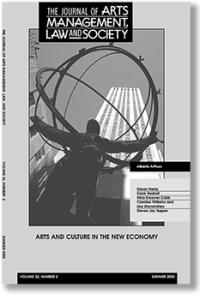
Author: Cobb, Nina Kressner
Publication Year: 2002
Media Type: Periodical (article)
Summary:
In this article I look at these new dimensions in charitable giving over the last decade—especially the rise of venture philanthropy—from the vantage point of arts and culture. Venture philanthropy has by passed the arts, but its rhetoric, principles, and priorities present challenges for arts and cultural institutions. Although venture philanthropy is neither as innovative nor as revolutionary as its proponents have claimed, some influential funders now look at philanthropic giving through a different lens and with a changed set of priorities. At the very least, arts and culture organizations need to be aware of these priorities and approaches to funding when formulating their own fund-raising strategies.
Abstract:
In the final years of the twentieth century, there was a great deal of talk about a phenomenon called the “new philanthropy” that had altered the philanthropic landscape. Broadly speaking, the term “new philanthropy” refers to a variety of late-twentieth-century developments, including the significant growth of individual giving in the 1990s, the creation of new foundations, the rise of such new funding mechanisms as charitable gift funds and e-philanthropy, the expansion of community foundations, and the emergence of venture philanthropy. Although no single definition can capture this phenomenon, it was characterized by three attributes: an increase in the available funds, an expansion in modes of giving, and a greater democratization of philanthropy.
In this article I look at these new dimensions in charitable giving over the last decade—especially the rise of venture philanthropy—from the vantage point of arts and culture. Venture philanthropy has bypassed the arts, but its rhetoric, principles, and priorities present challenges for arts and cultural institutions. Although venture philanthropy is neither as innovative nor as revolutionary as its proponents have claimed, some influential funders now look at philanthropic giving through a different lens and with a changed set of priorities. At the very least, arts and culture organizations need to be aware of these priorities and approaches to funding when formulating their own fund-raising strategies.
As this article goes to press, the weakening of the economy and the terrorist attacks of 11 September 2001 have set in motion profound changes in the funding world. A discussion of the specific impact of these events is beyond the scope of this paper. Nonetheless, I believe that however the ideas discussed here may be transformed, they will not be abandoned in the coming decade. [pages 125-6]
Arts & Intersections:
Categories: Fundraising, Funding, Creative Economies
ADDITIONAL BIBLIOGRAPHICAL INFORMATION
Series Title: The Journal of Arts Management, Law, and Society
Edition: Vol. 32, No. 2
URL:
SBN/ISSN:
Pages: 125
Resources: Document
PUBLISHER INFORMATION
Name: Taylor & Francis Group
Website URL: http://www.taylorandfrancisgroup.com/